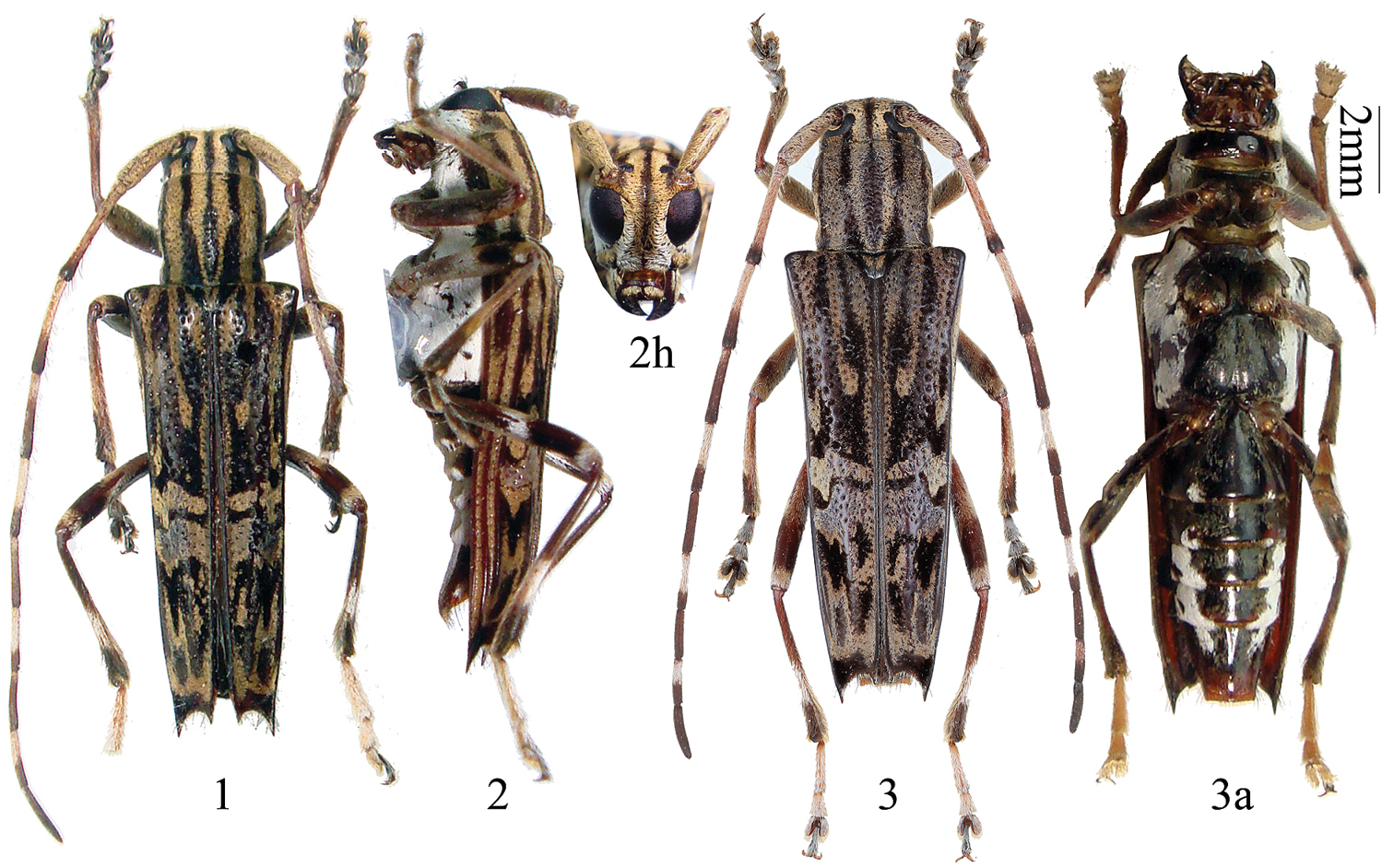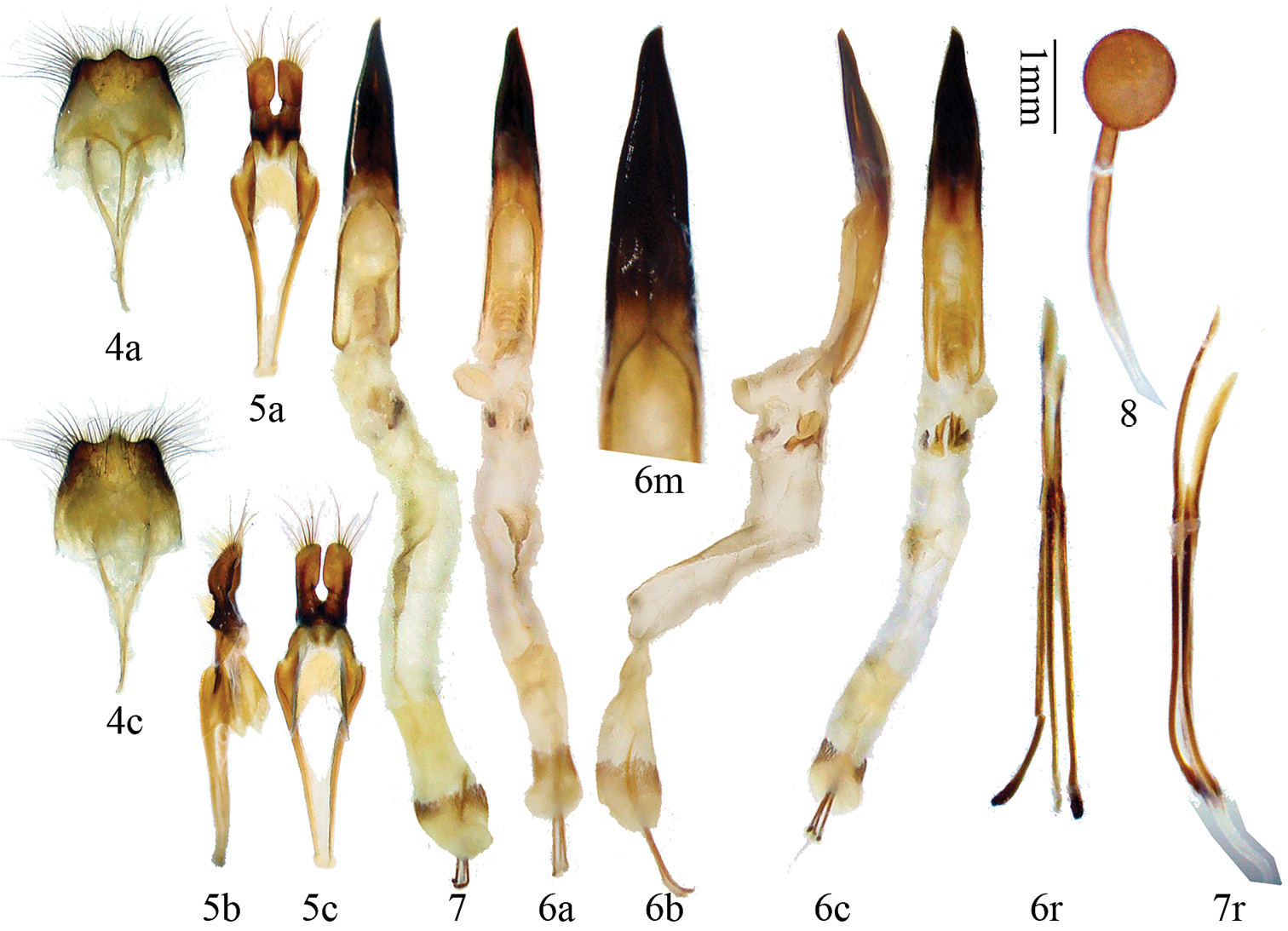






(C) 2012 Meiying Lin. This is an open access article distributed under the terms of the Creative Commons Attribution License 3.0 (CC-BY), which permits unrestricted use, distribution, and reproduction in any medium, provided the original author and source are credited.
For reference, use of the paginated PDF or printed version of this article is recommended.
A new species, Glenea jini sp. n. is described from Tibet, China. It can be separated from other species of the genus Glenea Newman by the complicated black and ochre markings as well as characters of the genitalia.
New species, taxonomy, Oriental region
In the progress of our research project on the “Study on the Systematics of Saperdini from China and the adjacent areas (Coleoptera: Cerambycidae: Lamiinae)”, many Chinese saperdine specimens have been recently collected as well as loaned from institutions, museums or private collections. In these collections two years ago, we found a noticeable new species from Tibet belonging to the genus Glenea. Since only male specimens were known, we were waiting for female specimens before officially publishing. Fortunately, during the first author’s visit to Shanghai Entomology Museum, some female specimens were found in their collection, and one fresh female was collected in August 2011 by a friend. In the current work, we describe this new species with detailed features of both the male and female genitalia.
Type depositories are abbreviated as follows:
CCCC Collection of Chang-chin Chen, Tianjin, China
IZAS Institute of Zoology, Chinese Academy of Sciences, Beijing, China
SHEM Shanghai Entomology Museum, Chinese Academy of Sciences, Shanghai, China
Resultsurn:lsid:zoobank.org:act:81EB4C33-7179-4CF6-8993-A02AABCA3EF9
http://species-id.net/wiki/Glenea_jini
Figs 1–8Male (Figs 1–2): length: 11.5–14.0 mm, humeral width: 2.5–3.9 mm. Female (Figs 3, 3a): length:12.0–15.0 mm, humeral width: 3.0–4.5 mm. Body dark brown to black, all with thick pubescence except ventral medial part. The pubescence in dorsal view is black and ochre, forming quite complicated markings on head, pronotum and elytra. The pubescence in ventral view is white. Head (dark brown to black Fig. 2h); frons with ochre pubescence, with white pubescence along eyes (only lower half) and from genae to clypeus; pubescence of genae and temple white with ochre; vertex with two parallel ochre stripes and one black stripe between upper eye lobes; behind eyes striped with vittae of black, ochre, black, ochre and finally white (the white pubescence surrounding lower half of inferior eye lobes); those vittae matching with the vittae of prothorax except one additional black vitta before white ventral pubescence on sides of prothorax. Antennae reddish brown mixing with black, scattered with black bristles on undersides of 1st to 8th segments; tips of 3rd, 4th, 6th, 8th, 10th and more than half apicalend of 5th, 7th, 9th segments, and the whole of 11th segment black, other parts covered with ochre and white pubescence. Prothorax with a medial black narrow stripe, then 6 stripes with alternating color of ochre and black on each side; prosternum with white pubescence, which extends to procoxal cavity. Scutellum black with ochre pubescence. Elytra black with complicated pubescent ochre stripes or vittae (Figs 1, 3): each elytron provided with three longitudinal stripes starting from the base, of which the middle one is the shortest, only reaching 3/10ths of elytron length; two transverse wavy vittae just behind midpoint; apical 2/5ths somewhat half black half ochre, with black apex. Sides of elytron covered with ochre pubescence except for the ridges and a black vitta after humerus (Fig. 2). Ventral surface mostly dark brown to black, with sides covered with dense white pubescence (Fig 3a). Legs reddish brown to black with white (sometimes mixed with some ochre) pubescence, especially middle and tip of hind femora, part of hind tibia, and first three tarsal segments covering with dense white pubescence.
Habitus, Glenea jini sp. n. 1–2 male, from Tibet, China 1 holotype, IOZ(E)1859443 2 paratype, IOZ(E)1859444. 2h. head, frontal view 3 paratype, female, from Tibet, China, photo by Wenxuan Bi. 3a. ventral view. Scale 2 mm.
Head slightly narrower than prothorax, closely punctured, feebly concave at vertex. Eyes deeply emarginate, inferior eye lobes slightly higher (female) or twice as high (male, Fig. 2h) as genae below it, width less than (female) or more than (male, Fig. 2h) half of frons. Antennae exceeding elytral apex in both sexes, but male is slightly longer than female; scape feebly thickened apicad, without any ridge, apex without cicatrix; ratio of the length of segments (male): 17 : 2 : 23 : 22 : 19 : 17 : 15 : 14 : 13 : 12 : 15; (female): 16 : 2 : 21 : 20 : 18 : 17 : 15 : 13 : 12 : 11 : 13.
Prothorax almost as broad as long (female) or slightly longer than broad (male), swollen laterally before middle; disc feebly convex and closely punctured.
Elytra angled at humeri, slightly narrowed apically, each with two longitudinal humeral ridges, first one beginning at humeri and not reaching to apex, second one beginning after humeri and reaching apical outer spine; apex emarginated apically, with shorter but sharp teeth at the suture, long sharp spine at the outer angle, disc with coarse and irregular punctures.
Legs stout; middle tibiae obliquely grooved ecto-apically; hind femur reaching 5th abdominal segment; 1st hind tarsal segment longer than following two segments combined in both sexes; male claws appendiculate; female claws simple.
Male genitalia (Figs 4–7): Tegmen approximately 3.4 mm in length; lateral lobes can be divided into two parts (Figs 5a–5c), basal 1/3rd thinner, with fine soft hairs in ventral groove (Fig. 5b), apical 2/3rds expanded in three directions (dorsal, ventral and inner), with apex obliquely rounded (in both ventral and outer directions) and with fine setae which are shorter than lateral lobes; ringed part elbowed in the widest portion, converging; basal piece bifurcated distally; median lobe plus median struts slightly curved (Fig. 6b), longer than tegmen in length; the median struts less than half of the whole length of median lobe; dorsal plate shorter than ventral plate; apex of ventral plate (Figs 6a, 6m, 7) pointed, apex a little sharp and curved to right side (in ventral view); median foramen (Fig. 6m) slightly elongated; internal sac approximately three times as long as median lobe, with 3–4 pieces of basal armature, two bands of supporting armature and three unequally long rods; the longest rod approx. 1.8 mm, roughly half the length of tegmen, the middle rod shortest. Ejaculatory duct single (Fig. 7r). Tergite VIII (Fig. 4c) broader than long, apical margin tri-lobed, of which the middle one is slightly longer than lateral ones; setae around sides slightly longer than the middle ones.
Female genitalia (Fig. 8): Spermathecal capsule with a slender basal stalk and a rounded apical orb, stalk more than twice the length of apical orb.
Terminalia of Glenea jini sp. n. 4 tergite VIII and sternite VIII & IX 5 tegmen 6 median lobe & internal sac of the male IOZ(E)1859444 7 median lobe & internal sac of the male IOZ(E)1859443 a ventral view b lateral view c dorsal view r rods of endophallus (not to scale) m magnified, showing apex of ventral plate of median lobe curved to right in ventral view (not to scale) 8 female genitalia, only showing spermathecal capsule (not to scale). Scale 1 mm.
Differs from other species of the genus Glenea by the complicated black and ochre markings and some characters of the genitalia, especially the three unequally long rods of the endophallus and the shape of the lateral lobes of the tegmen in the male. It resembles Glenea diversimembris Pic in the color of the pubescent markings, and the apex and humeral longitudinal ridges of the elytra, but differs in having annulate antennae; elytron with two transverse wavy vittae just behind middle; apical margin of tergite VIII (male) tri-lobed; apex of ventral plate of median lobe curved to right side (male); spermathecal capsule with a slender basal stalk and a rounded apical orb (spermathecal capsule of Glenea diversimembris without such rounded apical orb).
It resembles Glenea pallidipes Pic in the apex and longitudinal humeral ridges of the elytra, apical margin of tergite VIII (male) with a median protruding lobe, apex of ventral plate of median lobe curved to right side (male), spermathecal capsule with a slender basal stalk and a rounded apical orb; but differs in having annulate antennae; elytra with two transverse wavy vittae just behind middle; apical margin of tergite VIII (male) tri-lobed (without such lateral lobes in Glenea pallidipes); the slender basal stalk of spermathecal capsule not as curved as that of Glenea pallidipes.
From the color pattern, this species somewhat resembles Dystomorphus species (notatus Pic, esakii Hayashi, piceae Holzschuh), but differs in lacking lateral tubercles on the prothorax, the elytra bearing two longitudinal humeral ridges instead of one, and the elytral apex having a long and sharp spine at the outer angle, and so on.
The specific epithet is dedicated to Mr. Gentao Jin, a good collector, who has collected many specimens for IZAS and SHEM.
China: Tibet.
Holotype: China: Tibet: male (14.0 mm long), Mêdog, Hanmi, alt. 1100–2100 m (IZAS, IOZ(E)1859443). Paratypes: China: Tibet: 1 male, Mêdog, Xirang, alt. 600–700 m, 1981.IX.25, leg. Yinheng Han (IZAS, IOZ(E)1859444); 1 male, Mêdog, Baibung, alt. 940 m, 1979.VI.4, leg. Gentao Jin & Jianyi Wu (SHEM 24207072); 1 female, Mêdog, Baibung, alt. 1000 m, 2011.VIII.10, leg. Wenxuan Bi (CCCC); 1 female, Mêdog, Dexing, alt. 980 m, 1980.V.31, leg. Gentao Jin & Jianyi Wu (SHEM 24203410); 1 female, Mêdog, Dexing, alt. 900 m, 1980.VI.2, leg. Gentao Jin & Jianyi Wu (SHEM 24204637); 1 female, Mêdog, Kabu, alt. 1030–1670 m, 1980.V.11, leg. Gentao Jin (SHEM 24204617).
Most of the saperdine species were historically described based only on external characters, without any genitalia characteristics being provided (
We were surprised to observe the three unequally long rods of the endophallus in this species. According to the first author’s study on saperdine beetles from Oriental regions, even when there are three rods of the endophallus, usually two equally long rods form one pair (
We are grateful to Wenxuan Bi for his kind help during the first author’s visit to Shanghai and for taking photographs of the female. We wish to express our sincere thanks to Laurence Livermore (The Natural History Museum, London, UK), Steven W. Lingafelter (National Museum of Natural History, Washington, USA), and an anonymous reviewer for improving this manuscript. This research was supported by NSFC program 31000967 & J0930004 and a grant (No. O529YX5105) from the Key Laboratory of the Zoological Systematics and Evolution of the Chinese Academy of Sciences.

